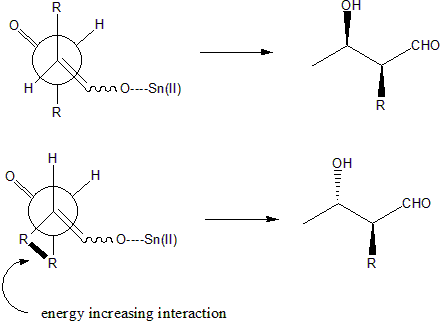For most aldol reactions, the relative 1,2-diastereoselectivity is a consequence of the enolate geometry.*
Both tin and titanium enolates are easily formed, and have been shown to exist predominantly in the (Z) configuration.
When reacting a cyclic (Zimmerman Traxler) TS, its commonly observed that (Z) enolates afford 1,2-syn aldol adducts, due to the orientation of the enolate (the (Z) enolate always has an axial R-group).
The following examples are instructive. In both cases (tin or titanium), we first form a (Z) enolate using the conditions shown. When the aldehyde (R-CHO) is introduced, chelation using the metal organises the Zimmerman Traxler TS. The lowest energy TS possible is the one in which the aldehyde is arranged with its bulky R group equatorial, however the enolate cannot put the methyl group (in this case) equatorial, as the enolate geometry enforces its axial positioning. Following both transition states through, we get the 1,2-syn aldol adduct in both cases.#

Image taken from Andy Myers' CHEM115 Handout: Stereoselective, directed aldol reaction
The description given in Carey is fundamentally incorrect for the reactions shown (even if it does predict the correct product). Looking at the references he gives, they're all fairly old, before more recent experimental and computation studies have validated the cyclic TS model for these kinds of metal enolates.
*: Mukaiyama aldol reactions do not conform to this, since they occur via a fundamentally different transition state (an open TS) to the Zimmerman Traxler model commonly found for other aldol reactions.
#: In this case, we also get enantioselectivity via the use of a chiral auxiliary, and depending on the metal used the enantioselectivity can be switched around due to chelation or lack thereof between the auxiliary and the metal


